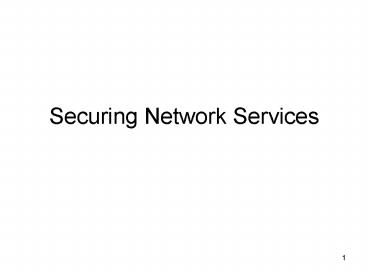Securing Network Services - PowerPoint PPT Presentation
Title:
Securing Network Services
Description:
Title: Securing Network Services Author: Timothy J. Shimeall Last modified by: Timothy J. Shimeall Created Date: 11/6/2003 9:30:31 PM Document presentation format – PowerPoint PPT presentation
Number of Views:63
Avg rating:3.0/5.0
Title: Securing Network Services
1
Securing Network Services
2
How TCP Works
- Set up connection between port on source host to
port on destination host - Each connection consists of sequence of numbered
packets, with source (port, address), destination
(port, address) and flags - First packet SYN (synchronize sequence numbers)
- Response packet - SYN ACK
- Thereafter ACK
- Last packet FIN ACK
- Ports are associated with services
- 21 - FTP
- 25 e-mail
- 80 - http
- many many more
- Based on client-server model
3
How UDP works
- Unreliable (unwarranted) delivery of information
between systems -- No acknowledgement - Ports for UDP services
- Port 123 -- Network Time
- Port 53 -- DNS
- Port 69 -- TFTP
- Port 514 -- Syslog
- Port 517 Talk
- Based on stateless distribution of information
4
Application Services
- Domain Name Service (DNS) -- TCP/UDP
- Replaced /etc/hosts files
- Tree-structured query system
- Replies -- either answer or reference to more
refined domain - Mail -- TCP (port 25)
- FTP -- file transfer protocol -- TCP
- HTTP -- World Wide Web -- TCP
5
TCP/IP Services
- Many have security risks
- Ways to access your computers
- Information on your computers and your users
- Can block them all (Paranoid approach)
- More often-- keep some, block others
- Blocking method -- firewalls
6
General Points
- Will discuss variety of services with security
implications - Not full list of internet services
- Not full list of security problems
- Administrators need to understand implications
before offering service - CERT advisories
- Configuration options
- Prudent attitude
7
User Education
- Suspicious network behavior
- Suspicious user behavior
- Who to contact
- When to contact
- Exercises
8
Web
- WWW World Wide Web
- System for automated information exchange
- Allows rapid access to flexibly-presented
information - Well over 50 of Internet traffic
- Presentation Options
- Formatted Hypertext
- Bitmap graphics
- Program execution (CGI scripts, Applets, etc.)
- Audio
- Movies
- Many more
9
WWW Threats
- Exploitation of server or script bugs
- Disclosure of unauthorized information
- Interception of confidential information
- Information loading from web client by rogue
server - Dependence on licensed software
10
WWW Risky Options
- Server-side includes
- Sending email from server
- Accessing PERL on server
- Spawning sub-processes
- Calling scripts outside of controlled directories
- Mixing HTTP and anonymous FTP
11
WWW Access Control
- Configure scripts to be read and executed only by
server - Use prudent access to exported files
- Dont use per-directory access files
- Use certified public keys for access
- Use server-side password for access
12
WWW Privacy
- Network-side
- Link encryption
- Document encryption
- Secure Socket Layer
- Secure HTTP
- All subject to limitations on Encryption
- Log files
- Restrict access
- Dont retain on server machine
- Use syslogd
- Warn users about logging
13
Web Browsers
- Executing code from the net
- Trusting vendors / Licensing
- Dependence on third parties
14
RPC
- Remote Procedure Call
- Calling program calls client code and waits
- Client code bundles parameters into message to
server (XDR - external data representation) - Server executes call with supplied data,
returning result in message to client code - Client code returns result to calling program
- Requires
- Client knowing server
- Client Server agree on communication
(portmapper) - Authentication
- Auth_none - live fast, die young
- Auth_UNIX - UID/GID authentication (trust client)
- Auth_DES - Secret/public key authentication(Diffi
e/Hellman key exchange, DES encryption) - Auth_KERB - Kerberos authentication
15
Kerberos
- Produced for MIT project ATHENA
- Authenticates
- User to client and server
- Client to server
- Server to client
- Centralized and stateless
- Passwords stored unencrypted on central server
- Never transmitted across network
16
Kerberos Protocols
- Login
- User enters username and password
- Client sends username and current time encrypted
with password - Server decrypts information and verifies valid
user - Returns session key encrypted with user password
- Service Request
- Client sends request to ticket-granting server,
encrypted with session key - TGS responds with identity of server, encrypted
ticket all encrypted with session key - Client passes encrypted ticket to server with
client IP and username































